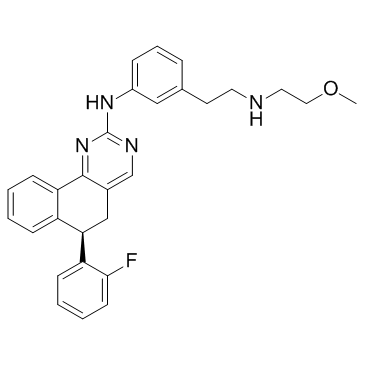| Description: |
Derazantinib (ARQ-087) is an ATP competitive tyrosine kinase inhibitor; exhibits potent activity against FGFR1-3 chondrocytes with IC50s of 4.5, 1.8, and 4.5 nM, respectively. |
| Target: |
FGFR1:4.5 nM (IC50)
FGFR2:1.8 nM (IC50)
FGFR3:4.5 nM (IC50) |
| In Vivo: |
Derazantinib is effective at inhibiting tumor growth in FGFR2 altered, SNU-16 and NCI-H716, xenograft tumor models with gene amplifications and fusions[1]. Most of the embryos exhibit abnormal external phenotype (81.3%) in Derazantinib-injected wings, possibly due to inhibition of proliferation of limb bud mesenchyme. The wings are shorter and thinner, with skeletal phenotype typical for FGFR inhibition, where ulna and radius are shorter or smaller in size, or occasionally missing completely[2]. |
| In Vitro: |
In cells, inhibition of FGFR2 auto-phosphorylation and other proteins downstream in the FGFR pathway (FRS2α, AKT, ERK) is evident by the response to Derazantinib treatment. Cell proliferation studies demonstrate Derazantinib has anti-proliferative activity in cell lines driven by FGFR dysregulation, including amplifications, fusions, and mutations. Cell cycle studies in cell lines with high levels of FGFR2 protein show a positive relationship between Derazantinib induced G1 cell cycle arrest and subsequent induction of apoptosis[1]. Derazantinib rescues the FGF2-mediated growth arrest with EC50 at about 100 nM, with no significant toxicity detected for up to 500 nM. The concentration range at which Derazantinib significantly suppresses the FGF2 effect is between 70-500 nM. Derazantinib inhibits FGF-mediated loss of extracellular matrix and induction of chondrocyte premature senescence. Derazantinib rescues FGF-mediated inhibition of chondrocyte differentiation in tibia cultures. Derazantinib inhibits FGFR1-4 but no other receptor tyrosine kinases in cell-free kinase assay. Derazantinib inhibits FGFR1 and FGFR2 mutants associated with craniosynostoses. Derazantinib rescues FGFR-mediated bone differentiation in mouse limb bud micromass cultures and ex vivo mouse calvarial organ cultures[2]. |
| Kinase Assay: |
Derazantinib is titrated in DMSO utilizing a 3-fold dilution scheme, and then diluted 10-fold further in deionized water for a final DMSO concentration of 10%. A volume (2.5 μL) of these dilutions or vehicle is added to each well of a reaction plate. FGFR1 or FGFR2 is added to assay buffer to each well in a volume of 17.5 μL for a final concentration of 0.50 or 0.25 nM, respectively. After a 30-minute pre-incubation period, ATP and substrate are added in assay buffer (5 μL) for final concentrations of 0-1,000 μM ATP and 80 nM biotinylated-PYK2, for a final reaction volume of 25 μL. The plates are incubated for 60 minutes at room temperature, and then stopped in the dark by the addition of 10 μL stop/detection mixture prepared in assay buffer containing EDTA[1]. |
| Cell Assay: |
Cells are seeded at 3000-5000 cells per well with 130 μL media in 96-well tissue culture treated plates. The cells are incubated overnight and subsequently treated with 3-fold serial dilutions of Derazantinib starting at 100 μM. The cells are returned to a 37°C humidified incubator for 72 hours. Cell proliferation is measured using MTS assay[1]. |
| Animal Administration: |
Mice: Female NCr nu/nu mice (SNU-16) or CB17 SCID mice (NCI-H716) with well established (400 mg) subcutaneous tumors are given a single oral dose of Derazantinib or vehicle control. Plasma and tumor samples are collected 4 hours post single dose. Derazantinib is administered orally. Dosing volume for all groups is 10 mL/kg or 0.1 mL/10 g body weight[1]. |
| References: |
[1]. Hall TG, et al. Preclinical Activity of ARQ-087, a Novel Inhibitor Targeting FGFR Dysregulation. PLoS One. 2016 Sep 14;11(9):e0162594.
[2]. Balek L, et al. ARQ-087 inhibits FGFR signaling and rescues aberrant cell proliferation and differentiation in experimental models of craniosynostoses and chondrodysplasias caused by activating mutations in FGFR1, FGFR2 and FGFR3. Bone. 2017 Dec;105:57-66. |






















